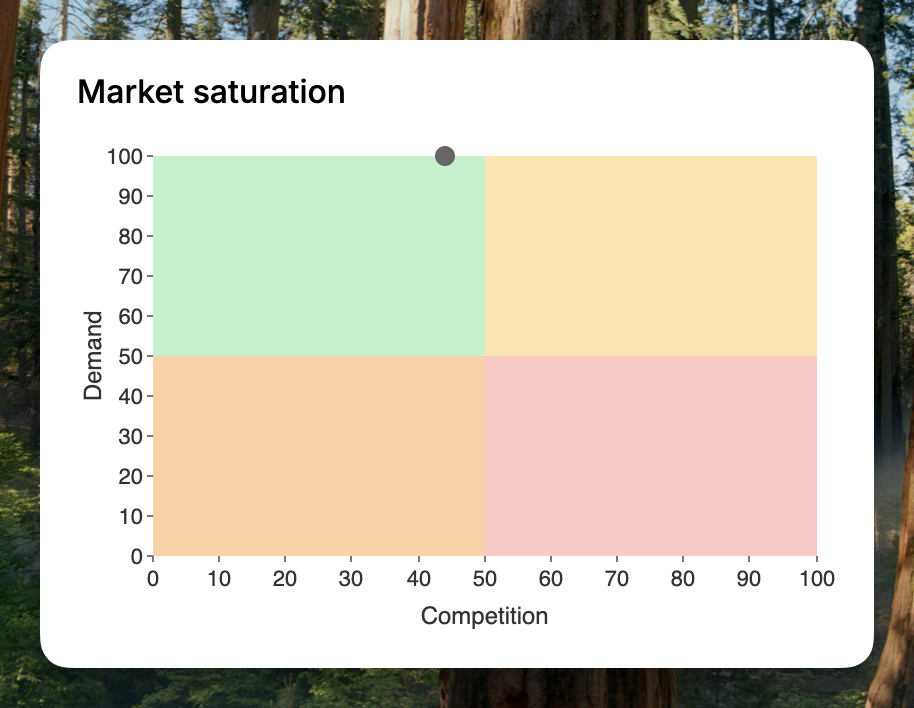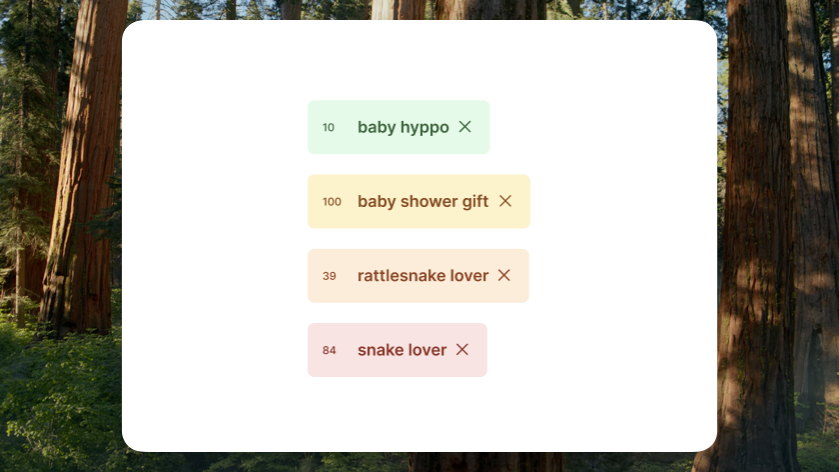Finding high demand / low competition tags for your Etsy listings.
Published onWe are often asked how to find high demand / low competition tags for Etsy.
Market research is an important part of being a successful Etsy seller, and Listadum is here to help with powerful tools like our Keyword Explorer.
All keywords are color-coded based on demand and competition. Let’s dive in and see what it really means:
Finding niches based on the market saturation of a tag
Understanding market saturation is key to finding good product niches that will sell on Etsy.
To visualize this, we can have look to one of our quadrant charts for the keyword “baby hippo”. In this example, the keyword is high demand with a low-average of competition, this is a great niche if your designs feature baby hippos!

The quadrant charts in Listadum have four zones:
- green: high demand / low competition
- yellow: high demand / high competition
- orange: low demand / low competition
- red: low demand / high competition
We base this on relative demand and relative competition, compared to millions of other tags. Note that Listadum does not “estimate” search volume as this metric can only be “guesstimated”… Etsy simply does not provide the search volume and everybody who claim having accurate search volumes is probably not telling you the whole truth.
What’s the best type of tags for my Etsy listings?
Well… it depends!
Irrespective of your standing on Etsy, green tags are always great to have for your primary keywords because they mean your product is in demand, and since there isn’t too much competition, you should be able to rank on page one.
Yellow tags are harder to rank for due to higher competition, so not only will you have to make your listing stand out, you’ll need to make sure it is greatly optimized to not only appear in search but also convert viewers into buyers. This is very important as momentum is the most important factor to keep appearing on page one.
Orange tags are not ideal for your primary keywords this means there isn’t much demand. But for secondary tags, it’s not all bad! Ever heard of “long tail keywords”?
Long tail keywords are great because:
- they help your listing show up on more search phrases thanks to the combinations;
- they help you capture views for these rarer search terms since there isn’t much competition, you have higher chances of appearing on the first page of search results.
Finally red tags really aren’t great for your primary keywords, this means what you make isn’t in demand, you should not expect to make many sales and there probably is no magic keyword out there that will solve that. Try to re-purpose your product toward another potential higher niche with more demand. For secondary keywords though, just like for orange tags, it’s not all bad.
Primary vs. Secondary keywords
But wait, you keep talking about primary vs. secondary keywords, what’s that?
Each listing usually have one to two tags of what we call “primary keywords”. Primary keywords are these tags that best describe your item, they are the first thing that comes to mind if you try to describe your product.
Usually, there is no need to try and be clever about it, if your item is poster showing different kinds of pasta, the primary keyword is going to be some variation of “pasta poster”.
In contrast to this primary keyword(s), all other keywords will be referred as “secondary”. The tags have less predictive power as to whether or not you’ll get views and sales, but they can help increasing the surface of search results you can appear int.
Based on the previous example of a pasta poster, since you should avoid repeating words in your tags, you should not have another tag saying “pasta”, therefore other tags should try to diversify and create a bigger variety of words by answering the question:
- what is it?
- what’s special about it?
- what is it made for? (only if people care to search for that)
- who is it for?
- is it a gift? if so who and when for?
- is it for a special occasion?
- etc.
In this case, what color should be the tags? For secondary tags, the color matters less but having a good mix of yellow / orange (and green if you find more without related keywords without repeating words!), and of course in this case, red are okay.
What’s that number next to the tag?

In Listadum, tags are often displayed alongside a number: the keyword difficulty.
The keyword difficulty is basically the competition you’ll find on this keyword, while the color give you a quick sense of where the tag would fall on the market saturation quadrants.
A difficulty between closer to 0 means it’s easier to rank on the first page of search results, while a number closer to 100 means your shop and listing must already have great momentum to appear on on page one.
How to find the best tags for your Etsy listings?
The Keyword Explorer of Listadum is the perfect place to find high demand / low competition keywords for your Etsy listings. With a database made of millions of possible tags, you’ll find all the information you need to find the best tags for your Etsy listings.
Check out this other article where we describe how to use it.